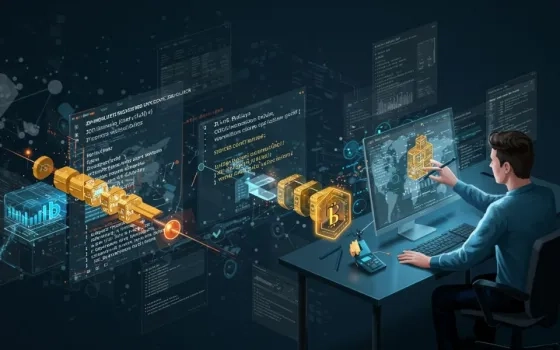The emerging digital economy is witnessing a transition and presenting new possibilities for Web3 and utility non-fungible tokens. Businesses are transitioning to Web3 technologies, including utility NFTs and the blockchain. The immutable public ledger helps to record all transactions in the form of tokens, making it possible for brands to build much deeper connections with their audience and communities.
Today, blockchain technology has revolutionized enterprises, from finance to healthcare. And now, it is disrupting the art and collectibles world. Non-fungible tokens (NFTs) and Web3, powered by blockchain technology, are creating a new economy for digital art and collectibles, enabling users with secure and transparent digital ownership of digital art and providing artists with new revenue streams and unique investment opportunities.
Due to the emerging technological advancement, a single user is no longer a number or data point for businesses. Rather, they are a unique and mapped identity that should be acknowledged and rewarded with token-gated content, rewards, members clubs, and even royalties. Creating new value for true consumers holds powerful benefits for rads in a Web3 economy. While Web2 witnessed a rise in socialization, Web3 is paving a new way to financialization. These technologies are establishing new business standards for collaborative commerce as well as inclusive practices for businesses to adopt and stay relevant.
Ethical Considerations in NFTs and Web3
The global nature of the digital economy created by Web3 is set to break down international boundaries for commerce and create new efficiencies, unlocking capital in assets.
Blockchain is assisting businesses in removing impediments that hinder engagement and breaking chains that restrict a user's ability to contribute meaningfully. These emergent technologies are democratizing customer loyalty models and providing unsung communities with a voice to interact with brands and businesses.
With trust, transparency, and sustainability being the major topics of concern in today's marketing landscape, decentralized tech platforms are positively modifying the dynamics between consumers and brands.
-
Transparency: Decentralized tech platforms help establish transparent and immutable records of tokens or transactions. This transparency further helps establish trust by allowing consumers to verify the integrity of the information provided by brands.
-
Smart Transactions - Smart contracts with predefined rules are encoded on a blockchain which helps in automating transactions and enforcing trust. By eliminating the need for a middleman, decentralized technologies help in reducing costs, increase efficiency, and enhance trust across business transactions. Transparency blockchain-based smart contracts further help in increasing confidence in consumers.
-
Personalization and Targeting: Web3 technologies are helping businesses with accurate and permission-based targeting. Users have control over their data, enabling them to choose and share specific information with enterprises they trust, thereby leading to accurate personalization. Marketers are focusing on creating value propositions to encourage users to share their information willingly.
-
User-generated Content: Web3 technologies are enabling organizations to promote communities and user participation. Marketers are able to leverage this by fostering user-generated content and brand communities. Companies are also focusing on building strong and engaged communities around their brands, thus driving retention and loyalty marketing strategy for growth.
-
Community Governance: Decentralized platforms integrate community-driven governance models where participants can make decisions collectively. This approach enables consumers to have a say in the policies and development of the platform. By involving consumers in decision-making processes, brands are able to build trust and demonstrate transparency, accountability, as well as responsiveness.
Blockchain is changing the world of digital content creation, ownership, and sharing. NFTs and Web3 are emerging as valuable tools in the art and collectibles market, authorizing artists and creators to monetize their work and connect with their fans.
However, on the contrary, NFTs and Web3 are raising ethical concerns regarding the environmental impact of blockchain mining. As NFTs and Web3 disrupt digital asset ownership and distribution, they are challenging traditional intellectual property and copyright laws. The energy-intensive process of cryptocurrency mining results in increased carbon emissions as well as energy consumption. NFT and Web3 platforms are prioritizing sustainable and energy-efficient practices to minimize their environmental impact.
To protect creators, ethical frameworks are being established through novel models that help in balancing fair compensation with wider access and circulation of digital assets. This direct relationship is leading to an increase in profits for companies as well as independent creators, enabling them to create more high-value and premium-priced NFTs.
NFTs and Web3: Advantages for Digital Art
Market-leading communities are evolving, enabling brands and businesses to create unique NFTs that interact with smart contracts and initiate the distribution of rewards, providing access to loyal customers. Web3 and utility NFTs are enabling brands to create a more engaging story and invite customers to have ownership in its evolution. With Web3 technology, users can also have a stake in that brand as well as a sense of belonging. Many NFTs can also act as digital key cards that remain locked until the users finish fun challenges to gain unlock access.
One of the key benefits of NFTs and Web3 is its ability to offer digital ownership and provenance to the owner through blockchain technology. With NFTs, creators have the power to establish a unique, tamper-proof record or token of ownership for their digital art. This helps them to monetize and gain profit from their creations. For collectors, NFTs provide a way to authenticate as well as verify ownership of valuable digital assets, thereby increasing their value.
Beyond establishing digital ownership, NFTs and Web3 hold promise for creators to earn more revenue streams. By verifying ownership and provenance, creators can sell their digital art on open marketplaces at fair prices. NFTs also enable the artists to earn royalties on secondary sales for their creations, thus ensuring that the artist reaps long-term benefits.
NFTs and Web3 are disrupting traditional art and collectibles markets as well by offering a more accessible platform for creators and collectors. Artists are able to bypass the traditional gatekeepers and reach a global audience of collectors by selling and trading their digital art and collectibles across blockchain marketplaces. Collectors can gain access to a wider range of valuable digital assets and create a more diverse and inclusive market.
The Future of Web3 and NFTs
The future of Web3 and NFTs looks promising, with significant growth and innovation leading to the emergence of new marketplaces expanding beyond the art and collectibles market and into virtual reality. But this growth and innovation will follow the need for ethical considerations and regulation in the sector.
With the rise in the participation of creators in the NFT and Web3 space, blockchain is redefining everyone's perception and how they interact with digital assets. The responsible and sustainable development of Web3 and NFTs, along with continuous collaboration among technology developers and policymakers, will help in ensuring a future that benefits all - creators, collectors, and society. However, it is equally important to balance the benefits of NFTs and Web3 with ethical and responsible deployment. They need to stay vigilant and work in collaboration to develop these technologies and incorporate them in a transparent, accountable, and environmentally sustainable way, thereby fostering a fair and accessible economy for digital art and collectibles.
With NFTs and Web3 becoming increasingly popular, it is critical that organizations ensure transparency and accountability in the marketplaces by addressing the environmental concerns around blockchain mining and protecting the intellectual property rights of the users. However, ethical concerns about the impact of blockchain mining and transparency in NFT marketplaces require attention. Businesses are navigating the transformative impact of NFTs and Web3 on the art and collectibles market and exploring new opportunities and obstacles presented by this technology.
















